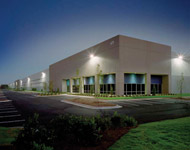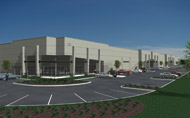|
COVER STORY, DECEMBER 2005
INDUSTRIAL RISINGS
New projects underway in Miami and Atlanta.
Daniel Beaird
Southeast Real Estate Business has explored three new industrial developments in the Southeast, two in the Atlanta area and one in the Miami area. Both cities have experienced an increase in industrial activity in 2005.
Atlanta is among the top five industrial markets in the United States, and 2005 has proven to be a strong year for the city. With its excellent highway system and world-class airport as well as its railroad system, the Atlanta area is the southeastern hub for the industrial market. In Austell, Georgia, Opus South is in various stages of constructing buildings at its Hartman project. IDI is also developing Hamilton Mill Business Center in Buford, Georgia.
 |
Opus South's 353,983-square-foot Hartman I in Austell, Georgia, is part of a planned five-phase development.
|
|
Opus South's Hartman project includes Hartman I, a 353,983-square-foot facility that was completed in 2004. Currently, the building has 65,000 square feet of vacant space. Hartman II is a rear-load facility under construction; it targets tenants of 100,000 to 150,000 square feet. The 525,392-square-foot Hartman III was completed in August. Opus South hopes to have leases signed for Hartman III in the next 3 to 6 months. Hartman IV and V are future opportunities for Opus South to develop build-to-suits on the Austell site in 2006. If Hartman IV and V's future tenants need it, Opus South will explore the possibility of expanding Hartman III. The Interstate 20 corridor has become an important logistics area in Atlanta. “Many of the industrial facilities that companies used in the Fulton industrial area have grown older and obsolete, and companies are looking to consolidate into one building that can provide better clear heights,” says Duane Wood, vice president of Opus South's Atlanta office. “So, the Hartman buildings fit that niche along the I-20 corridor.”
Opus South has developed more than 1.5 million square feet of industrial space across Atlanta during the past 3 years. “The industrial market in Atlanta is relatively healthy,” Wood says. “It is just a matter of keeping supply in check with demand.”
IDI's vice president of leasing, Lisa Ward, agrees. “Atlanta has seen a tremendous up-tick in activity compared to last year,” Ward says. “We are seeing a good turnaround in the bread-and-butter deals, the 40,000- to 60,000-square-foot deals as well as the consolidations of the large distribution centers into 1 million-square-foot requirements.”
 |
IDI's Hamilton Mill Business Center in Buford, Georgia, will ultimately feature 12 buildings. Building A's rendering is featured.
|
|
IDI, which has developed approximately 12.5 million square feet of industrial space across Atlanta, acquired the 250-acre Hamilton Mill Business Center, located northeast of Atlanta in Buford, in late 2000. The company immediately began construction on a build-to-suit for Office Depot, which was completed in July 2001. The 550,000-square-foot bulk distribution center became Office Depot's Southeast distribution center. After 9/11, IDI slowed construction at Hamilton Mill until 2004. Building M, a 650,000-square-foot bulk distribution facility with a 34-foot clear height, was completed last July. IDI hopes to have a significant portion of it leased by year's end. Hamilton Mill also includes an 80,000-square-foot build-to-suit for FedEx Corporation that will be completed this month. Finally, Building B, the most recent development at Hamilton Mill, is a 138,000-square-foot rear-load facility that will target smaller tenants than Building M. Hamilton Mill is expected to contain 12 buildings totaling 4 million square feet. The buildings will range in size from 55,000 to 1.1 million square feet when the industrial park is built out in the next 5 years.
Hamilton Mill is IDI's replacement for Shawnee Ridge,” Ward says. “Shawnee Ridge is situated 5 miles south on Satellite Boulevard and is completely leased out.” There is a reason IDI chose to stay in the northeast suburbs of Atlanta. “The northeast submarket is the largest in metropolitan Atlanta with about 145 million square feet,” Ward says. “And Buford offers excellent incentives to industrial tenants that are not offered by unincorporated Gwinnett County.” Some of those incentives include being exempt from the county tax for schools, as Buford operates its own school district. Therefore, the tenant would save approximately 8 cents per square foot on its property taxes. The city of Buford also provides its own power source and the utility rates are much less than some of the competitive areas of Gwinnett County.
Because Atlanta has been heavily developed during the past few years, industrial developers are finding land scarce across the city. The same problem has arisen in Miami.
Lincoln Property Company has acquired the last parcel of industrial land in Medley, Florida, a submarket of Miami. The 40-acre Lincoln Logistics Park was acquired in August and is still in the planning stages. The Airport West section of Miami is the major industrial sector in the area and it has overflowed into Medley, which sits just north of Airport West. Medley is a town that comprises only 1,000 people and is very open to industrial development, which brings daytime employment to the area.
The 40-acre Lincoln Logistics Park in Medley, which is Lincoln Property's only industrial development site in the Miami area, is still in the planning stages. “Three or four buildings with 660,000 to 700,000 square feet of build out is planned for the park,” says Steve Medwin of Lincoln Property Company. “We will build what the tenant needs including speculatives, build-to-suits and design-builds.” Lincoln Property is seeking distribution companies to fill its future space. “Fortune 500 to mom-and-pop businesses need to be in the Miami area for its airports and seaports,” Medwin says.
Like Atlanta, Miami's industrial market has rebounded in the past few years. New industrial spaces are being leased as soon as they are being built. Rental rates are increasing as vacancy rates drop to as low as 4 percent in some areas. “Industrial buildings are selling for $80 to $90 per square foot,” Medwin says. “Construction costs and the lack of industrial land as well as interest rates have kept the market high.” Land prices have risen from $6 to $15 per square foot, according to Medwin, because residential developers can pay more money than industrial developers and use the land sooner. Demand outpaces supply for industrial land and space in the Miami area.
©2005 France Publications, Inc. Duplication
or reproduction of this article not permitted without authorization
from France Publications, Inc. For information on reprints
of this article contact Barbara
Sherer at (630) 554-6054.
|
